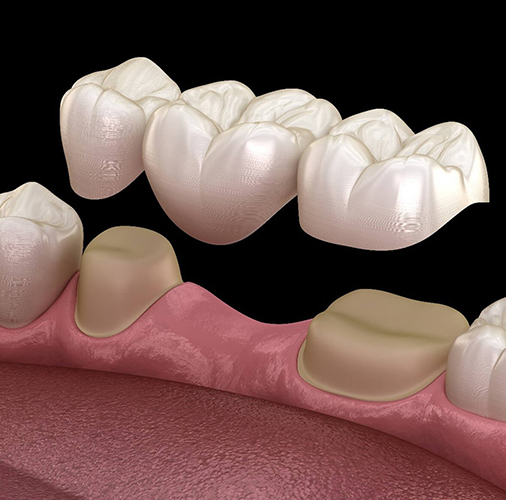
We specialise in Dental Bridges that will help restore the look and functionality of your teeth where a missing tooth/teeth will be replaced artificially.
Dental Bridges
We are a multi-clinic practice with cosmetic dentist specialists who are industry experts dedicated towards creating beautiful smiles through cosmetic dental procedures including dental bridges that offer a permanent solution for missing teeth. The primary goal of Mouth Dental is to always exceed customer expectations by providing our patients with a clinic where they can address all their dental needs under one roof. Mouth Dental is a beacon in the dental industry as more and more people appreciate the value of dental hygiene and cosmetic dentistry for overall health and wellbeing.
What are Dental Bridges?
A dental bridge makes daily activities such as eating and talking easier, while boosting your confidence in your smile. Bridges replace missing teeth without the need for surgery, unlike dental implants. Thanks to its porcelain finish, the new false tooth is almost indistinguishable from your natural teeth.
Gaps between teeth can cause teeth to move into the space or lean over, while food can get trapped in the spaces, increasing the risk of tooth decay. Dental bridges are an investment you will make towards your oral health and quality of life.
What dental conditions require dental bridges?
If you have a missing tooth or teeth owing to gum disease, tooth decay or an injury, this procedure, as the name indicates, will bridge the gap. Even if you are missing teeth owing to a congenital condition you can get a dental bridge. The only requirement is that you need to have healthy teeth on either side of the missing one, known as anchor or abutment teeth.

Treatable Cases


Meet your dentists

Dr. Helen Ngo
South Quay, Canary Wharf | Nine Elms, Battersea
Helen qualified from King’s College, London, in 2007. She has since attained Postgraduate Certificates in Orthodontics at Warwick University and Dental Education at University of Bedfordshire. Helen is an Invisalign Diamond provider with a passion for digital dentistry.
Helen’s passion is improving smiles using Invisalign, followed by tooth whitening and restoring worn and chipped teeth with composite bonding. She enjoys using the iTero scanner for most of her work and has a mostly impression- free digital workflow for Invisalign system, retainers, dental veneers, crowns and bridges. Helen frequently works closely with implant specialists to help coordinate complex treatment plans requiring Invisalign prior.
Helen takes great care that each case is finished neatly with a easy to maintain retention protocol with fixed retainers and Vivera retainers. She takes great pride in her neat fixed retainers.
Helen is a friendly and caring dentist, with a very approachable nature. She thrives to see the joy shown by her patients when they get the beautiful smile they always wanted. Helen is fluent in Cantonese.
Dr. Connie Yau
Nine Elms, Battersea
Connie studied dentistry at King’s College London. Since her graduation, Connie has invested heavily in additional training in aesthetic and restorative dentistry, learning from the leaders of the industry.
Connie is a general dentist with an interest in smile design and aesthetic dentistry, interests that pair well with her status as an Invisalign and SmileFast provider. Connie has helped many patients improve their smiles and confidence through alignment, whitening and composite bonding. Connie has been complimented on her ability to work with anxious patients and children through her caring and gentle approach.
Connie is a sedation provider, a service that assists in treating patients with dental anxiety.
Away from work, Connie enjoys running and walks with her partner and their dog, Pete. Connie and her partner also enjoy exploring London’s many restaurants and travelling the world together.

Health benefits of dental bridges
There are a number of reasons as to why you may need a dental bridge:
- Restoring your ability to eat and speak properly
- Restoring your smile
- Redistributing the force of your bite
- Preventing teeth from drifting out of position
- Maintaining the shape of your jawbone
What are the different types of dental bridges?
There are four main types of dental bridges available and depending on your condition you will be recommended type of dental bridge most suitable for you.
Traditional
This is the most popular type of dental bridge and is suitable if you have your natural teeth on either side of the gap. A Traditional dental bridge consists of a false tooth called a pontic, held in place by dentals crowns, that have been cemented into place via the abutment teeth. These dental bridges are ceramic porcelain fused to metal or depending on preference, all metal like gold.
Your cosmetic dentist will shape and file the two adjacent teeth, so that the two dental crowns fit perfectly. This procedure is typically for the restoration of back teeth such as molars and premolars. Traditional bridges are strong and durable and with proper care can last a long time.
Cantilever
Though similar to traditional bridges, the cantilever bridge procedure is mainly used to restore front teeth as they are not strong enough to support back teeth restoration. To support this bridge you have one natural tooth remaining next to the missing tooth, as the bridge is held in place by a dental crown that is cemented to the abutment tooth.
Maryland
Maryland bridges also called adhesive bridges are less invasive than traditional bridges, with a fake tooth supported by a metal framework of either metal or porcelain, bonded onto the back of the abutment teeth. This why Maryland bridges need two natural teeth on either side of the gap but use less tooth structure removal before placement when compared to other types of dental bridges.
These bridges are suitable for restoring incisors and rarely used to restore canines or molars, because Maryland bridges can shift or loosen easily they are not suitable for teeth that are used for biting and chewing.
Implant-supported
Implant supported bridges are used to restore premolars and molars and are supported entirely by dental implants, instead of dental crowns or a metal framework. If you have more than three missing molars in a row, then this is the type of bridge suitable for you.
This entails one implant being surgically placed for every missing tooth. The implants hold the bridge in position and if it is not possible to add an implant for each missing tooth then the bridge may have a pontic suspended between the two implant supported crowns.
Implant supported bridges are the strongest and most stable of the bridges and generally requires two surgeries to complete the process, one to embed the implants into the jawbone and the second to place the bridge. This can take several months to be finished completely.
How do dental bridges work?
To ensure your comfort and reduce pain a local anaesthetic is usually administered. Thereafter the abutment teeth are shaped and filed in preparation to create a clear path to the other tooth. Impressions are made and sent to a dental lab where your custom dental bridge is created. Till this is ready, you will be fitted with a temporary bridge over the newly shaped teeth and gap.
If your existing surrounding teeth are not strong enough for this, then dental implants will be placed into your jawbone for an implant supported bridge.
Once your permanent bridge is ready the temporary bridge will be removed, and your teeth cleaned. If there any sensitivity you will be given a local anaesthetic and your dentist will also take x-rays to ensure that the permanent bridge fits correctly. If everything is perfect then the bridge and teeth are bonded together using special dental cement.
Dental Bridges vs Implants
The main difference is that dental bridges may need to be replaced every 5 to 15 years, depending on the care you provide. Dental implants are considered as permanent. However both dental bridges and implants require good dental hygiene in order to maintain their expected life span.
Why choose us to get you dental bridges done?
We offer you a professional and caring service after our experts assess and review your specific dental requirements.
Book your virtual consultation
Begin your personalised smile transformation at Mouth Dental.
Book your free consultation with us now and let’s discuss treatment options to help you get that perfect smile!

Frequently asked questions
Are dental bridges the right treatment for me?
If you have one tooth missing but two strong and intact teeth on either side of the gap then dental bridges are the right treatment for you. As each patient is different you will be recommended the best type of dental bridge treatment for you after an initial consultation.
How long does the procedure take?
Generally you would need two visits, the first one to anchor your teeth or implants and prepare them for the crowns that will hold the bridge into place. The second is to place the permanent bridge and check and adjust for perfect fit and comfort. Both visits should last about an hour to an hour and a half, depending on the amount of work involved. This is for the non-surgical dental bridges and based on you having strong teeth on either side of the gap.
What is the recovery period?
It should take about two weeks for you to fully adjust to the dental bridge. Your teeth may feel very sensitive for the first few days and so you should avoid very hot or cold beverages and food.
Are dental bridges permanent?
Only dental-implants are considered as permanent where as other types of bridges are expected to last anywhere between 5 to 15 years, based upon the level of care and dental hygiene you maintain.
